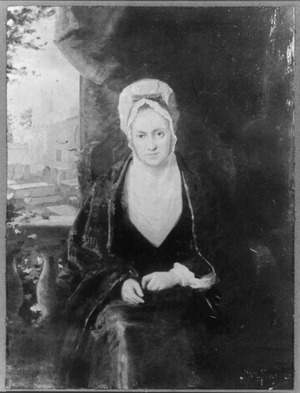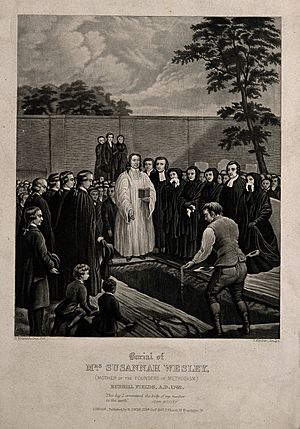Susanna Wesley facts for kids
Quick facts for kids
Susanna Wesley
|
|
|---|---|
 |
|
| Born |
Susanna Annesley
20 January 1669 London, England
|
| Died | 23 July 1742 (aged 73) |
| Occupation | "Mother of Methodism" |
| Spouse(s) | |
| Children | Samuel Wesley (the Younger), John Wesley, Charles Wesley Emilia, Susanna, Mary, Benjamin, Mehetabel, Anne, Martha, Kezia |
| Parent(s) | Samuel Annesley Mary White |
Susanna Wesley (born Susanna Annesley; January 20, 1669 – July 23, 1742) was an important woman in English history. She was the mother of John Wesley and Charles Wesley, who later became famous leaders of the Methodism movement.
Even though Susanna never preached or wrote books, she is often called the "Mother of Methodism." This is because her sons, John and Charles, learned many important lessons from her. They used these lessons to help start and grow the Methodist Church.
Contents
Susanna's Family Life
Susanna Wesley was the 25th of 25 children! Her father, Dr. Samuel Annesley, was a Dissenter. This meant he did not agree with the official Church of England. However, when Susanna was 12, she decided to join the Church of England herself.
On November 11, 1688, Susanna married Samuel Wesley. She was 19 years old, and he was 26.
Susanna and Samuel had 19 children together. Sadly, many of them died when they were very young. Nine of her children died as babies, and four of these were twins. Only eight of her children were still alive when Susanna passed away.
Challenges in Susanna's Life
Susanna faced many difficult times. Once, her husband left her and their children for over a year after a disagreement.
She also dealt with money problems. Her husband, Samuel, was even put in jail twice because he couldn't pay his debts. Their home burned down two times. During one fire, her son John almost died and had to be rescued from a second-story window.
Susanna was the main teacher for her children. She taught them at home. After the second fire, the family's house needed to be rebuilt. Susanna had to send her children to live in different homes for almost two years. She was upset when they started using bad language and playing more than studying.
Susanna's Teaching Methods
Susanna had strict rules for her children's education. They did not start lessons until they turned five years old. But the day after their fifth birthday, their formal schooling began.
They had classes for six hours each day. On their very first day, they were expected to learn the entire alphabet! Most of her children managed to do this. Susanna made sure her children received a good education. Both her sons and daughters learned Latin and Greek. They also studied classic subjects that were common in England at that time.
Leading Sunday Services
One time, while her husband was away in London, he sent a temporary preacher to their church. This preacher's sermons were only about repaying debts. Susanna felt her family and the local people needed more spiritual teaching.
So, she started holding family services on Sunday afternoons. They would sing a psalm, and then Susanna would read a sermon from her husband's or father's notes. After a while, local people began asking if they could join. Soon, more than 200 people were attending Susanna's Sunday afternoon services! Meanwhile, the regular Sunday morning church service had very few people.
Susanna practiced daily prayers and spiritual reflection throughout her life. She wrote about her own spiritual journey and God's grace.
Susanna's Writings
Susanna's husband, Samuel, spent his whole life and all their money on his studies of the Book of Job from the Bible. However, his work was not well-remembered.
In contrast, Susanna wrote many important pieces that helped educate her children. Besides letters, she wrote her own thoughts and comments on the Bible. She wrote long explanations of the Apostles Creed, the Lord's Prayer, and the Ten Commandments. Many of these writings were lost in the rectory fire, but some still exist today. You can find her writings in a book called Susanna Wesley, The Complete Writings.
Susanna was buried at Bunhill Fields in London.
Susanna Wesley in Movies
Susanna Wesley's life has been shown in films:
- In 1954, a film called John Wesley was made. It told the story of John Wesley's life. Curigwen Lewis played Susanna Wesley.
- In 2009, a movie called Wesley was released. June Lockhart played Susanna Wesley in this film.



